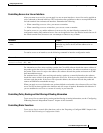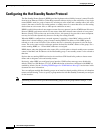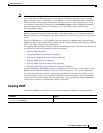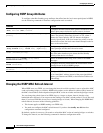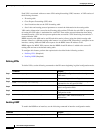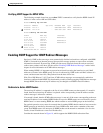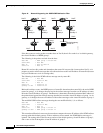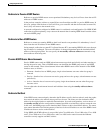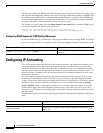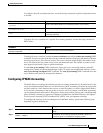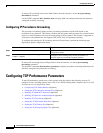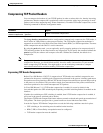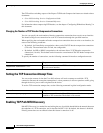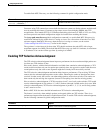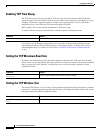
Configuring IP Services
Configuring the Hot Standby Router Protocol
IPC-107
Cisco IOS IP Configuration Guide
Redirects to Passive HSRP Routers
Redirects to passive HSRP routers are not permitted. Redundancy may be lost if hosts learn the real IP
addresses of HSRP routers.
In the previous example, redirects to router R8 are not allowed because R8 is a passive HSRP router. In
this case, packets from the host to Net D will first go to router R1 and then be forwarded to router R4,
that is, they will traverse the network twice.
A network configuration with passive HSRP routers is considered a misconfiguration. For HSRP ICMP
redirection to operate optimally, every router on the network that is running HSRP should contain at least
one active HSRP group.
Redirects to Non-HSRP Routers
Redirects to routers not running HSRP on their local interface are permitted. No redundancy is lost if
hosts learn the real IP address of non-HSRP routers.
In the example, redirection to router R7 is allowed because R7 is not running HSRP. In this case, the next
hop IP address is unchanged. The source IP address is changed dependent upon the destination MAC
address of the original packet. You can specify the no standby redirects unknown command to stop
these redirects from being sent.
Passive HSRP Router Advertisements
Passive HSRP routers send out HSRP advertisement messages both periodically and when entering or
leaving the passive state. Thus, all HSRP routers can determine the HSRP group state of any HSRP
router on the network. These advertisements inform other HSRP routers on the network of the HSRP
interface state, as follows:
• Dormant—Interface has no HSRP groups, single advertisements sent once when last group is
removed
• Passive—Interface has at least one non-active group and no active groups, advertisements sent out
periodically
• Active—Interface has at least one active group, single advertisement sent out when first group
becomes active
You can adjust the advertisement interval and holddown time using the standby redirects timers
command.
Redirects Not Sent
If the HSRP router cannot uniquely determine the IP address used by the host when it sends the packet
that caused the redirect, the redirect message will not be sent. The router uses the destination MAC
address in the original packet to make this determination. In certain configurations, such as the use of
the standby use-bia interface configuration command specified on an interface, redirects cannot be sent.
In this case, the HSRP groups use the interface MAC address as their virtual MAC address. The router
now cannot determine if the default gateway of the host is the real IP address or one of the HSRP virtual
IP addresses that are active on the interface.
Using HSRP with ICMP redirects is not possible in the Cisco 800 series, Cisco 1000 series, Cisco 1600
series, Cisco 2500 series, Cisco 3000 series, and Cisco 4500 series routers because the Ethernet
controller can only support one MAC address.



